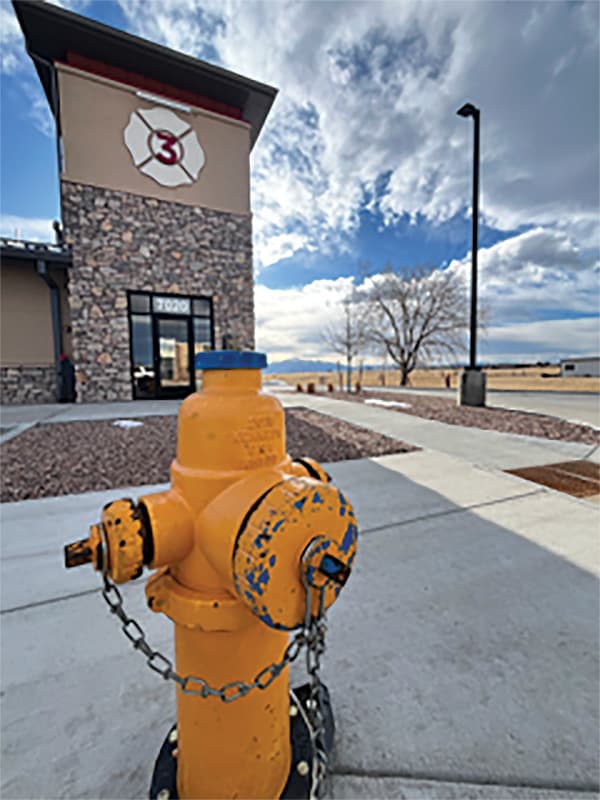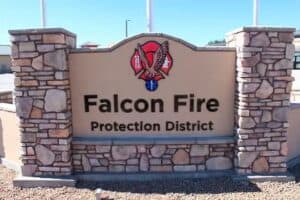By Jon Huang
I moved to Colorado because of the mountains. Six years later, I have stayed because of the people. Over a year ago, I left medicine to write. To loosely quote Anton Chekhov, medicine was my lawful wife, and writing was my mistress. Balancing the two has been part of this journey.
A friend and a Falcon local told me about an opening at The New Falcon Herald. My first assignment: the monthly board meeting of the Falcon Fire Protection District.
The following Wednesday afternoon, in a room full of firefighters, I find myself wading through a deluge of new terms. Afterward, I sign up for a ride-along to see what a life of a firefighter looks like in this growing town.
One week later, Bobby opens the front door to Falcon Station #1.
“Hey, welcome, glad to have you.”
Bobby retired from the U.S. Army and has been firefighting for two years. He shows me the kitchen, the gym, the bedrooms and inside the ambulance.
Firefighters work 48 hours straight. Training, eating and workouts are done when they can. Calls are unpredictable in timing and frequency. Sometimes it’s serious and sometimes it isn’t, Bobby says, but you never know until you get there, which makes things challenging.
All firefighters in Falcon are EMTs, which requires a few months to a year of training and allows them to do some basic procedures, give certain meds and perform CPR. Paramedics, on the other hand, have more extensive clinical training allowing them to administer a wider range of medications and perform a greater range of procedures. Some fire departments require their firefighters to be paramedics. Here in Falcon, they do not. Each team has one or two paramedics.
“Hopefully, we’ll get you an interesting medical case,” Bobby says.
Interesting is not always good, I think to myself.
Bobby is cooking breakfast this morning for the team. On the menu: cheesy scrambled eggs and bacon-wrapped steaks. As we wait, I meet Justin, Travis and Jason.
Justin is a paramedic. He performs the initial medical triaging, administers medications, intubates and performs other emergent procedures.
I watch as he seasons the steaks.
“Salt much?” Travis deadpans.
Lt. Travis is a 15-year veteran of the force. He performs firefighting duties while supervising the team.
At the counter, Jason unpacks his meals for the day. He is ex-Army, a massage therapist, built like a bodybuilder and the only one eating vegetables.
Overhead, the radio blares. The dispatch call center is separated for the county and for Colorado Springs. Calling 911 gets you one or the other. Every vehicle has a number like “304,” and each digit specifies town, vehicle and station number.
There are different types of fire vehicles besides fire engine trucks. Tender trucks carry the most water, generally between 1,800 to 3,000 gallons. Pumper tender trucks have high-volume pumps, which quickly feed the others. The brush trucks’ smaller size helps them efficiently access brush fires. Ladder trucks give access to higher structures, assist with rescues and are used to spray water from an elevated position. Ambulances transport the sick and injured.
Around 11:30 a.m., we head to Station 6. Here, they practice breaking into garage doors, metal doors and roofs using a diamond blade circular saw, burly crowbars and a long chainsaw.
Jason and Bobby don their suits, shouldering their oxygen tanks, each lasting 15 to 45 minutes.
At the end of the session, I catch Jason as he’s packing up.
“Best job in the world!” he beams.
“Quite a change from your past life?”
Jason worked as a military contractor in Iraq, got paid twice as much, but needed a change.
“I needed a job where I felt like I had a strong sense of purpose. You know what I mean?” he says.
Back at the station, it’s nearly 3 p.m. A few of the guys are at the table finishing lunch.
As I wait for my lunch to finish heating, I notice the cookie tin on the counter and grab myself two butter cookies.
“If you’re here between Thanksgiving and New Years, it’s a sea of diabetes.” Jason bellows from the table.
Since I haven’t eaten since 7 a.m., diabetes never tasted so good.
Jason notices the carrots and parsley in my split pea and barley soup.
“See, he likes his vegetables, too,” he yells at Travis, who is sitting down to a plate of grilled steak and potatoes.
Over the radio, a call comes in concerning a patient with slurred speech.
When we arrive, the family tells us they noticed increased confusion and slurred speech that started a day prior. They are concerned, but the patient is not.
Justin does his assessment. The man’s pupils are constricted, his oxygen levels are at 78% without oxygen (normal is typically above 90%), and his speech is slurred. He is concerned that this could be related to the opioids the man has been taking for his knee pain. The man disagrees.
“I just need sleep,” he says.
Justin explains that if it’s not from the medication, he can’t completely rule out more serious issues like a stroke and says he would have to go to the hospital to be evaluated for that.
“With your oxygen levels being as low as they are, if you sleep, I am concerned you might not wake up,” Justin says.
The man declines to go.
Outside, Travis explains that if there is concern a patient is mentally impaired either from medical or mental health concerns and is at risk for self-harm, an M1 hold can be placed to keep them for 72 hours. This generally requires police or physician involvement.
Justin gets the physician on the phone, who reiterates his concerns with the patient.

After they speak, Justin proposes a trial of Narcan, a medication which can quickly reverse the effects of opioids, to determine if that is the only thing going on.
The patient refuses any treatment.
Justin updates family and lets them know they can call back if there are any concerns; we leave, nearly 90 minutes later.
Justin explains he had a strong suspicion that this was related to opioids but felt directly confronting the patient would have caused more resistance. As a medical first responder, shared decision-making with the patient is the ideal, but one must consider whether the patient can understand the gravity of the situation, respect patient autonomy, all the while weighing the imminent necessity of medical intervention.
The case demonstrates that while health care professionals are trained to deal with medical problems, sometimes their role does not always involve medical intervention. Sometimes, they can only convey to the patient the potential harm of the situation. Sometimes, they must allow patients to make decisions that they themselves might not agree with. In all circumstances, they must fulfill their role in a way that serves their fellow man.
“How was that for an interesting medical case?” I ask Bobby later.
“Maybe we’ll be back in a couple hours.”
Ever the optimist.
Stay connected with the Falcon Fire Protection District
- Website: http://www.falconfirepd.org
- Facebook: Falcon Fire Department
- Twitter: @FalconFireDept




